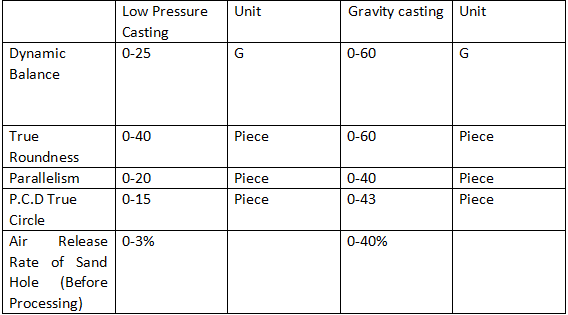As the automotive culture grows, more and more individuals learn to distinguish between the factory hub and the more common aftermarket hub. The market has seen the introduction of a flood of new wheel hubs. On the basis of material, wheel hubs are often classified as either steel wheel hubs or aluminum alloy wheel hubs. Hubs for aluminum-alloy wheels are often made from either aluminum or magnesium-aluminum alloy. Steel wheels are becoming rare in the Chinese vehicle industry. The wheels of modern automobiles are often made of aluminum alloy and are cast or forged. Gravity casting and low-pressure casting are now the most often used casting techniques. Our knowledge of these two manufacturing methods will be discussed today. Low pressure and gravity are clearly evident while casting wheel hubs. The question is, which is preferable?

Casting with Gravity
The pressure in the flow of molten aluminum into a mold cavity originates from the self-weight of the metal, which is why gravity casting relies on this property of the metal so heavily. Gravity casting, the most basic casting technique, is labor-intensive because of its reliance on physical labor and unreliable because of its poor technical content.
Once the mold is in place, the aluminum solution is poured in via the pouring port and gradually fills the mold as gravity does its work. When the mold has hardened, you may open it to reveal a gravity casting wheel.
Due to its minimal initial investment and simple setup using preexisting molds, gravity casting is often used by smaller manufacturing facilities. Raw material consumption is high, and quality control in mass manufacturing is difficult because of fluctuating ambient conditions and the inherent difficulty in artificial casting. This method of manufacturing is no longer being used at all by automakers that experience high demand for Lunyi. However, stores in the auto parts industry that are open to new trends and are price conscious might benefit more from carrying such items.
Casting with a Low Pressure
In low-pressure casting, molten aluminum is forced upwards from the bottom of the mold until it cools and forms into a crystal structure. Because the whole procedure is automated, the process level is consistently high. When comparing manufacturing costs, low-pressure casting is more expensive than gravity casting. However, most automakers today use low-pressure casting to guarantee the integrity of the wheel hub, which is crucial for the safety of the whole vehicle.
Casting at low pressure involves securing a mold above a pool of aluminum solution heated to a high temperature, then injecting dry compressed air into the pool to create a gas pressure that forces the aluminum solution into the mold’s cavity. This process is repeated until the aluminum solution has solidified throughout the casting.
Because of careful pressure regulation during the casting process, the resulting molded casting has a higher density material than would be possible with standard gravity casting. Low-pressure casting, under the same circumstances, may achieve higher performance. Furthermore, low-pressure casting may be accomplished for certain very difficult wheel hub geometries. However, as molten aluminum has a limited ability to flow, finishing the wheel’s intricate design is either impossible or results in a much lower yield.
The above summary of the wheel hub production process makes it abundantly clear that low pressure casting offers technological benefits over gravity casting:
The hub of the wheel is well balanced; it is both dynamically stable and has a genuine round shape. Inner and outer wheel diameters under 30g have much worse dynamic balancing performance than wheels made using the conventional gravity technique. The data of the traditional gravity casting is 45g-60g or more, which makes the driving more stable and stable.Organization of the wheel hub: the internal organization of the wheel hub can be more dense and the safety can be greatly improved by evenly delivering the pressure to the wheel hub mold. Generally, the traditional gravity casting has no pressure transmission, and the hub structure is relatively loose.
Strength of wheel hub: low-pressure casting method, using low-pressure feeding, greatly increases the strength of wheel hub, at least 30% more than gravity casting. For example, OEM aluminum wheels of major automobile factories at home and abroad all adopt low-pressure casting method, which proves that the strength performance of traditional gravity casting is not stable.
Safety of wheel hub: The pressure delivery system of low-pressure casting will not be affected by the environment and climate change, and can produce products with safe and stable quality throughout the year. Generally, traditional gravity casting is vulnerable to the impact of climate, temperature and humidity, and the product quality is unstable.
Compare with some data that will affect driving comfort:

From the above data, it is not difficult to see that the data performance of low-pressure casting is superior to that of traditional gravity casting. All the data that will affect the smooth and comfortable driving are relatively strong, so the low-pressure casting hub with excellent balance is far more than that of traditional gravity casting hub.

